#sri lankan character
Explore tagged Tumblr posts
Text

supernova <33
#original character#my art#oc#digital art#artists on tumblr#original art#my artwork#illustration#character illustration#black artists on tumblr#sri lankan character#witch#witch art
13 notes
·
View notes
Text
Day 224
Today’s Asian character is Amara Perera from Marvel Comics!
She is Sri Lankan.



5 notes
·
View notes
Text
On Dragon Age & Accents
(My unhelpful tuppence, as an English player.)
One small thing I wish had come up in Veilguard from previous games: the accent worldbuilding. It wasn't always consistent - DA:O only seemed to care about country or race, anyone non-human being generically North American and anyone human being mostly RP English unless they were Antivan; for regional accents, they seemed to purely use them for effect or go with VAs' natural ones. (There are about two bandit NPCs who seem to have badly-done Midlands English accents purely because they're not meant to be very bright; thanks, love Canadians reinforcing that stereotype. Anders being Lancashire seems to be pure coincidence because of his voice actor - you rarely ever hear the accent in any consistent way in other NPCs, and it's completely ignored in his very Southern DA2 recast.)
But by DA2, there seemed to be definite trends: Free Marches could be RP English or North American depending where you came from; dwarves tended to sound North American but there were exceptions for some people raised on the surface; elves tended to be either Welsh or Irish, which matches the "very old culture with a linguistically completely different root from Trade/English". Starkhaven is most definitely Scots.
And then DAI! DAI, my love.
DAI kept DA2's trends, while finally giving us more complexity and regional accents, albeit limitedly (and still with some inconsistencies). Finally, we have a (vaguely Germanic) Nevarran accent! And Miranda Raison did such careful work constructing it! The Avvar, Ferelden's mountain folk, sound Northern English. I'd hazard a guess that several sound Yorkshire, actually - this matches the whole "the Orlesians got up there less" lore in real terms; Northern England and Scotland, particularly Yorkshire, was under Viking rule longer than the South, which became Norman-conquered earlier, and there are subtle dialectal differences to this day. (Similar thing happened with the Celts and Romans, and the Avvar are blatantly Celtic and Pictish). There's a reason that RP ("neutral posh") English is Southern, from the seats of power. Cullen's from Honnleath, somewhere smaller and less Orlesianified, and while it's softened by the character's travel and the VA's own posher bents, there are moments the Northern English accent gets leaned into, a little similarity with the Avvar. It's a coincidence but it works so well, lore-wise. Sera's VA sounds... Derbyshire? I think? which is Midlands/Northern border and sounds more than Northern enough to keep a consistent Fereldan sound. And in terms of NPCs? A lot of Fereldan NPCs suddenly start turning up Northern, albeit less broad in their accents! Have a listen round the Crossroads. I remember Gaider mentioning Dorian wasn't originally meant to be Indian, they sealed it for sure when they cast Ramon Tikaram, at which point everyone went, "Yup, let's run with it", cast his dad accordingly, and Gaider figured that Dorian was either part of a pretty big migrant population (which, other than the Dorian Gray reference, the fact his name roughly means "from across the sea" also makes sense), or quite a lot of Tevene folk natively were. Considering Tevinter started as essentially "mage Rome" and morphed into, even according to the writers themselves, "mage Byzantium" and it's very close to Seheron, which I feel is North Africa/Middle East influenced - Tevene folk being akin to folk of Turkish, Middle Eastern, Indian, Pakistani, Bangladeshi, Sri Lankan and Bengali backgrounds makes a ton of sense.
It is... exceedingly rare to hear working-class British accents in fantasy series at all (unless Brits make them, and then we're still often peasants or generic NPC #2, a la Origins). It is even rarer to have a fantasy series bother to keep immigrant accents and show the moulding of them through the generations. And I can only think of one other video game that has consciously cast British Asian actors, that's how rare it is even in games that supposedly care about representation - despite the fact that Asian folk make up something like 30% of our population.
Now: would I like some more background on why some accents in the Marches sound British and some don't? Yup! Would I have liked to have more regions in the elves' Irish accents and the dwarves' NA? Yup! But do those really matter? Nope! They would have been lovely icing on the cake, but the underlying cake was great. The plot didn't need it. It didn't have to be perfect, and the filtering of British culture through Canadians, and strategic anachronism? Those are things I love about Dragon Age. I loved how much they seemed to be trying and how much they were thinking about the lore. And I loved hearing a "British accent" that finally made sense to me, not played into the long attempts by toffs to stamp out everything North of London or outside England.
And then Veilguard sort of... forgot about it most of it? Adored that we could play as a Geordie! I really, really love them continuing pointed casting of folk with British Asian ancestry for several Tevinters (*waves lovingly at elek and neve*). But then... uh... look! Working-class Tevene people with generic Mancunian accents! To show they're working-class! That's fantastic progress... for Origins. But lore-wise, by DATV we've already shown that Manchester and Northern English accents live... *points at Ferelden* somewhere over there. We're back to "Tevinters mostly sound like generically evil English folk", as in DAO and bits of 2, which, sure, Dorian doesn't contradict - but then why not have everyone sound Southern, like him? Or add a different tint to it? And no, I am not saying everyone should put on bad "ethnic" accents, and I do appreciate the number of American, English and Mediterranean accents in Tevinter showing a very Roman "you're a citizen of the Imperium but you might have been born in one of its several countries" - but…
Gideon Emery's slight Afrikaans tint made a ton of sense with Fenris and what part of Tevinter he was meant to be from, even if it was unintentional; Jennifer Hale's take on Krem was going for English but came out more Aussie to my ear. Something like those could have been really interesting. But that also means that, including Fenris, we've now had several slaves with an accent that reads... quite posh, to English ears. Same with Neve, who is supposedly proudly from the shithole part of Minrathous, but she and several others have very RP "posh" accents (while others like Tarquin and Elek are Mancunian). Now, not everyone picks up their local accent! I am one of those people! I ended up cursedly plummy for a long time! But... we had hints through the series that Tevinter class markers would be very different from Fereldans', but they're now the same, for some reason?
Add that to the fact that they didn't want to make even one VA suffer through doing the Nevarran accent... See, it makes total sense for Emmrich, who's a posh professor who's done a lot of international study and would probably have learned Common as a second language with a very generic, "neutral" accent; he also was very concerned about appearances with his class background and trained himself not to give much away. And I'm sure the Mourn Watch has international students. But no Nevarran NPCs sound pointedly Nevarran? Not a one? Kal Sharok has hints of something interesting going on but it's rare, and the Anderfels is just... full of sad English and American-sounding people. Rivain is supposedly Caribbean and there are a bunch of actors of Caribbean descent they could've cast, but we only have one NPC sound even slightly so? That's when it stops being "Trade is taught with a neutral accent and there are a lot of Fereldan immigrants and slaves in Tevinter" and starts feeling handwavey.
Basically: I wouldn't mind if we'd gone with most fantasy games' "Eh, we cast broadly based on sound, stereotype or none of the above"; I'm very happy to just go with it. However, DAI told me to pay vague attention because the accents meant something. Then DATV has heel-turned and is telling me "Nah, go with it" the way Origins did. My ears are... confused, to say the least. And we're back to "'working-class' has one accent, and characters with something to say who aren't cast as stereotypically plucky underdogs are all Southern and posh", which just... makes me really sad. I don't hear people who sound like me, my family, or my friends growing up, in Dragon Age anymore. I did hear they had a different voice director in DATV, so maybe it's that?
#veilguard critical#dragon age inquisition#dragon age#meta#ie me rambling#it's a 'mildly critical' i think?#it's not a big part of the game and i doubt many people noticed. it doesn't ruin anything. i just miss some bonus things#folks who are scottish/irish/welsh/canadian/usian please nudge me if i've got something wrong or you want me to include something#there are some accents i can't hear nearly as well in terms of picking out regions so this is very much missing info in parts i think#tru plays veilguard
328 notes
·
View notes
Text
Sri Lankan Fairies and Senegalese Goddesses: Mixing Mythology as a Mixed Creator
[Note: this archive ask was submitted before the Masterpost rules took effect in 2023. The ask has been abridged for clarity.]
@reydjarinkenobi asked:
Hi, I’m half Sri Lankan/half white Australian, second gen immigrant though my mum moved when she was a kid. My main character for my story is a mixed demigod/fae. [...] Her bio mum is essentially a Scottish/Sri Lankan fairy and her other bio mum (goddess) is a goddess of my own creation, Nettamaar, who’s name is derived from [...] Wolof words [...]. The community of mages that she presided over is from the South Eastern region of Senegal [...] In the beginning years of European imperialism, the goddess basically protected them through magic and by blessing a set of triplets effectively cutting them off from the outside world for a few centuries [...] I was unable to find a goddess that fit the story I wanted to tell [...] and also couldn’t find much information on the internet for local gods, which is why I have created my own. I know that the gods in Hinduism do sort of fit into [the story] but my Sri Lankan side is Christian and I don’t feel comfortable representing the Hindu gods in the way that I will be this goddess [...]. I wanted to know if any aspect of the community’s history is problematic as well as if I should continue looking further to try and find an African deity that matched my narrative needs? I was also worried that having a mixed main character who’s specifically half black would present problems as I can’t truly understand the black experience. I plan on getting mixed and black sensitivity readers once I finish my drafts [...] I do take jabs at white supremacy and imperialism and I I am planning to reflect my feelings of growing up not immersed in your own culture and feeling overwhelmed with what you don’t know when you get older [...]. I’m sorry for the long ask but I don’t really have anyone to talk to about writing and I’m quite worried about my story coming across as insensitive or problematic because of cultural history that I am not educated enough in.
Reconciliation Requires Research
First off: how close is this world’s history to our own, omitting the magic? If you’re aiming for it to be essentially parallel, I would keep in mind that Senegal was affected by the spread of Islam before the Europeans arrived, and most people there are Muslim, albeit with Wolof and other influences.
About your Scottish/Sri Lankan fairy character: I’ll point you to this previous post on Magical humanoid worldbuilding, Desi fairies as well as this previous post on Characterization for South Asian-coded characters for some of our commentary on South Asian ‘fae’. Since she is also Scottish, the concept can tie back to the Celtic ideas of the fae.
However, reconciliation of both sides of her background can be tricky. Do you plan on including specific Sri Lankan mythos into her heritage? I would tread carefully with it, if you plan to do so. Not every polytheistic culture will have similar analogues that you can pull from.
To put it plainly, if you’re worried about not knowing enough of the cultural histories, seek out people who have those backgrounds and talk to them about it. Do your research thoroughly: find resources that come from those cultures and read carefully about the mythos that you plan to incorporate. Look for specificity when you reach out to sensitivity readers and try to find sources that go beyond a surface-level analysis of the cultures you’re looking to portray.
~ Abhaya
I see you are drawing on Gaelic lore for your storytelling. Abhaya has given you good links to discussions we’ve had at WWC and the potential blindspots in assuming, relative to monotheistic religions like Christianity, that all polytheistic and pluralistic lore is similar to Gaelic folklore. Fae are one kind of folklore. There are many others. Consider:
Is it compatible? Are Fae compatible with the Senegalese folklore you are utilizing?
Is it specific? What ethnic/religious groups in Senegal are you drawing from?
Is it suitable? Are there more appropriate cultures for the type of lore you wish to create?
Remember, Senegalese is a national designation, not an ethnic one, and certainly not a designation that will inform you with respect to religious traditions. But more importantly:
...Research Requires Reconciliation
My question is why choose Senegal when your own heritage offers so much room for exploration? This isn’t to say I believe a half Sri-Lankan person shouldn’t utilize Senegalese folklore in their coding or vice-versa, but, to put it bluntly, you don’t seem very comfortable with your heritage. Religions can change, but not everything cultural changes when this happens. I think your relationship with your mother’s side’s culture offers valuable insight to how to tackle the above, and I’ll explain why.
I myself am biracial and bicultural, and I had to know a lot about my own background before I was confident using other cultures in my writing. I had to understand my own identity—what elements from my background I wished to prioritize and what I wished to jettison. Only then was I able to think about how my work would resonate with a person from the relevant background, what to be mindful of, and where my blindspots would interfere.
I echo Abhaya’s recommendation for much, much more research, but also include my own personal recommendation for greater self-exploration. I strongly believe the better one knows oneself, the better they can create. It is presumptuous for me to assume, but your ask’s phrasing, the outlined plot and its themes all convey a lack of confidence in your mixed identity that may interfere with confidence when researching and world-building. I’m not saying give up on this story, but if anxiety on respectful representation is a large barrier for you at the moment, this story may be a good candidate for a personal project to keep to yourself until you feel more ready.
(See similar asker concerns here: Running Commentary: What is “ok to do” in Mixed-Culture Supernatural Fiction, here: Representing Biracial Black South American Experiences and here: Am I fetishizing my Japanese character?)
- Marika.
Start More Freely with Easy Mode
Question: Why not make a complete high-fantasy universe, with no need of establishing clear real-world parallels in the text? It gives you plenty of leg room to incorporate pluralistic, multicultural mythos + folklore into the same story without excessive sweating about historically accurate worldbuilding.
It's not a *foolproof* method; even subtly coded multicultural fantasy societies like Avatar or the Grishaverse exhibit certain harmful tropes. I also don't know if you are aiming for low vs high fantasy, or the degree of your reliance on real world culture / religion / identity cues.
But don't you think it's far easier for this fantasy project to not have the additional burden of historical accuracy in the worldbuilding? Not only because I agree with Mod Marika that perhaps you seem hesitant about the identity aspect, but because your WIP idea can include themes of othering and cultural belonging (and yes, even jabs at supremacist institutions) in an original fantasy universe too. I don't think I would mind if I saw a couple of cultural markers of a Mughal Era India-inspired society without getting a full rundown of their agricultural practices, social conventions and tax systems, lol.
Mod Abhaya has provided a few good resources about what *not* to do when drawing heavily from cultural coding. With that at hand, I don't think your project should be a problem if you simply make it an alternate universe like Etheria (She-Ra and the Princesses of Power), Inys (The Priory of the Orange Tree) or Earthsea (the Earthsea series, Ursula K. Le Guin). Mind you, we can trace the analogues to each universe, but there is a lot of freedom to maneuver as you wish when incorporating identities in original fantasy. And of course, multiple sensitivity readers are a must! Wishing you the best for the project.
- Mod Mimi
#asks#multiracial#multicultural#south asian#sri lankan#senegalese#west african#identity#representation#worldbuilding#fantasy#mythology#folklore#fairies#deities#adoption#identity issues#mixed experiences#coding
633 notes
·
View notes
Note
PLEASEPLEASE PLEASE PLEASE
are there any characters you associate with sri lankan culture? yeah its probably barely heard of because of how small of a country it may be BUT kandyan dancing!!!! milk rice (kiribath) !!!!! AND KOTHU MEE
because your cultural designs are ♡ and i have yet to see people doing anything sri lankan themed
just trust me /nf if u dont wanna though
and chenyu vale is so so very sri lankan coded (even if it wasnt intended)
just consider it. think bout it. a little. maybe. 👍

Oh I’ve been THINKING……
I hc her with super looooooonnnnnggg proportions to accentuate her dancing
Finding a happy medium between her cannon design and culturally accurate clothing was hard so apologies if I got things wrong
I have actually eaten kiribath before….i actually eat it up so much even though i hate coconut.
I like it with extra of the sauce(????????topping??) on top so nilou will too
#genshin impact#genshin fanart#my art#nilou#genshin nilou#genshin impact nilou#gi nilou#nilou fanart#nilou my beloved#genshin impact fanart#genshin redesign#nilou if she was based
131 notes
·
View notes
Text
Riordanverse race/nationality headcanons (Main characters and background characters alike)
This may be a very long post, and I’m throwing in little tidbits about appearances, so with no regard to any particular order, strap in:
(Seriously, this is a huge post)
Edit: Changed Luke from just Korean American to mixed Argentinian/Korean American, inspired by @tagthescullion
The Seven (Including Nico and Reyna):
Percy Jackson: Biracial White/Latino, Cuban American (Sally was born in Havana, she had Percy shortly after moving to the US)
Annabeth Chase: Biracial Black/White, Irish/African American (with Swedish, Ghanaian and Polish descent)
Jason (And Thalia, by extension) Grace: White German American (Beryl moved from Germany to the US)
Piper McLean: Native American, Cherokee
Leo Valdez: Latino, Mexican, Born in Texas
Hazel Levesque: Black, African American, New Orleans (1940's French Creole)
Frank Zhang: Chinese Canadian, Vancouver
Nico Di Angelo: White, Italian with Russian descent, 1920’s Venice
Reyna Avila Ramirez Arellano: Latina, Puerto Rican
Camp Half Blood:
Will Solace: Biracial White/Bangladeshi American, Texas
Luke Castellan: Mixed Argentinian/Korean American (Born in the US, May (or Mi-Hee) grew up in a Argentine Korean community in Buenos Aires before she moved to the US and met Hermes)
Malcolm Pace: White with albinism, Scottish, Glasgow
Travis and Connor Stoll: Mixed Scottish and Laotian, Edinburgh (Source: @freddie-77-ao3)(I think in the TV show, they cast two Asian boys as the Stolls, so I've made them Asian)
Alice Miyazawa: Japanese American, Los Angeles
Julia Feingold: White Luxembourger, Luxembourg City
Cecil Markowitz: White Austrian/Northern Irish (Born in Graz, grew up in Belfast since he was two, has dual citizenship)
Katie Gardener: White Scottish, Aberfoyle
Castor and Pollux Vintner: Black, Irish (Pollux is Albino, Castor wasn’t), Donegal
Michael Yew: Mixed Irish and Chinese, Limerick (Granny moved from China)
Lee Fletcher: White Irish, Donegal
Clarisse La Rue: Mixed French/Pakistani American, Arizona (Mother moved from France)
Chris Rodriguez: Afro-Latino, Nicaraguan (Moved to the states when he was seven, lived in the same neighbourhood as Clarisse)
Silena Beauregard: Blasian, African American and Filipino, Mississippi (French descent)
Charles Beckendorf: Black, African American
Jake Mason: White American, Wyoming
Harley Smythe-Davidson: Biracial White/Aboriginal Australian (Source: @freddie-77-ao3)
Nyssa Barrera: Latina, Panamanian, Panama City
Shane O’Doherty: White Irish, Laois
Christopher Chalkevas: White Greek/English (Born in Larissa, moved with his mother to Hackney, London at age five, has dual citizenship)
Clovis Karlsen: Wasian, Welsh (Welsh/Norwegian grandad, Indonesian granny, Source: @ashthenerdtheythem)
Chiara Benvenuti: White Italian, Florence
Alabaster C. Torrington: British Indian, English, Westminster
Lou Ellen Blackstone: Black with vitiligo, British Ghanaian, Birmingham
Drew Tanaka: Japanese American, New York City
Valentina Diaz: Latina, Colombia
Mitchell Singh-Donovan: Mixed Indian and Irish, Cork
Lacy Alfsen: White Danish, Copenhagen
Ethan Nakamura: Japanese, Tokyo
Damien White: White Irish, Northside Dublin
Miranda Gardiner: Vietnamese American, Massachusetts (Distant Irish ancestry)
Billie Ng: Wasian, Irish/Thai Canadian, Toronto (She grew up in Longford till she was seven, then she and her mortal dad moved to Canada)
Sherman Yang: Chinese American, Alaska
Marcus (Mark) Dooley-Wallace: White Irish American, Georgia
Ellis Wakefield: Black, Algerian
Holly and Laurel Victor: Sri Lankan American, Seattle
Meg McCaffery: Wasian, Irish/Vietnamese American
Camp Jupiter:
Dakota Cheshire: Black, Bermudian
Gwendolyn Nunez: Hispanic, Spanish American
Bobby Herrera: Latin American, New Mexico
Lavinia Asimov: White Russian, born in San Francisco
Larry Schumacher: White American, North Carolina
Leila Grunfeld: White American, Colorado
This has been a very exhausting post to make lmao. I gave some of the characters who don’t have canonical surnames my own Hcs for their surnames. Also, I am yet to read through trials of Apollo, so maybe I’ll come later back to add more Roman names to the list.
Tagging my moots that I like to see their opinions for this (as well as the ones I tagged within the list as well):
@aki-bara @ravingcoffeeaddict @ebony-reine-vibes @squiggle3worm @sleep-needer
#percy jackson#annabeth chase#jason grace#piper mclean#leo valdez#hazel levesque#frank zhang#nico di angelo#reyna avila ramirez arellano#will solace#luke castellan#malcolm pace#travis and connor stoll#alice miyazawa#julia feingold#cecil markowitz#katie gardner#castor and pollux#michael yew#lee fletcher#clarisse la rue#chris rodriguez#damien white#silena beauregard#charles beckendorf#pjo#hoo#toa#riordanverse#misc skeptic thoughts
130 notes
·
View notes
Text
"We will close all gender studies and throw out these professors!"
I was actually kind of horrified when she said that
In germany, gender studies had been abolished once before: 1933. It was the first thing Hitler burned down once he was in power.
Alice Weidel, Magnus Hirschfeld and Hitler
Alice Weidel
Alice Weidel is a joke character truly. A right-wing extremist woman in the AfD, who is married to a sri-lankan woman, living in Switzerland.
She purposfully refuses the label "lesbian", because she hates queer people. She constantly talks about "remigration", foreigners and how much she despises them, calling them "Messermörder" (Knifemurderers), a slur, and yet she is technically married to a foreigner herself. The AfD party also doesn't believe gay couples should be allowed to adopt children, and yet she and her partner have adopted children.
(allegedly her children had to change schools due to bullying over Alice Weidel being their mother, however I could not find anything to prove that, but it's a funny thought)
Considering this woman is just a walking condradiction. I always wonder how she is even allowed to participate in german politics when she isn't even living here.
Wenn sie so auf Abschiebung steht, warum schieben wir sie nicht bitte ab??
Magnus Hirschfeld
Towards the end of the Kaiserreich and during the Weimar Republic Magnus Hirschfeld lived. He was the pioneer of "Sexualwissenschaften", research of sexuality, gender identity, intersex people and most things queer. He himself was also gay and polyamorous, and also jewish. He was the founder of the "Insitute for sexual science", the first in the world.

He helped people understand who they were, others to understand that queer people weren't sick or unnatural and created acceptence for them. He even created a "Transvestitenschein", which let people dress as the opposite sex without punishment. He also contributed to a movie about being gay and the discrimination they faced under § 175, which made homosexuality illegal. It's called "Anders als die Andern" or "Diffrent from the others" from 1919.

During those days Berlin was somewhat of a queer haven
Well, until Hitler took over
The first thing he did was burn Magnus Hirschfelds institution to the ground along with many books of opposing ideologies. Which is excatly what Alices speech reminded me of.
Magnus fled the country and never returned. He died in 1935 in Nizza, where his grave also stands. On it it says "PER SCIENTIAM AD JUSTICIAM"; With science to justice. His life motto.
The clip at the start was taken from her recent speech at the AfD-Parteitag. It was her speech for kanzlernomination. Besides abolishing gender studies, she also wants to fully rid germany of this "Queerwokenwahnsinn" (Queer woken craziness) and "weg mit linker ideologie" (away with left-ideology), and of course deporting the "Messermörder" and "Silvesterbomber" (New years eve bombers), but also everyone else who isn't "Aryan" probably. And not to forget her whole "interview" with elon musk and the "hitler was a communist".
what the fuck
Everyday we get closer to letting the fascists take power, the same mistake the weimar republic made in the 1930s. The signs are there. Back then they said "we didn't know", which wasn't justified even then, but now; if we let this all happen again we might not even get the chance for stupid excuses. The whole world is drifting right and it will only continue further if we don't do something.
#history#magnus hirschfeld#alice weidel#german politics#holocaust#shoah#queer#lgbt#lgbtq#lgbtqia#politics#remigration#deutschland#deutsche politik#bundestagswahl#bundestagswahl 2025#ww2#ww2 history#ww2 germany#weimar republic#weimar#far right#dictatorship#fuck elon musk#elon musk#fuck elon#presidential election of 2024#us politics#american politics#mkf327
40 notes
·
View notes
Note
hello! i saw you talk abt queer desi literature and was wondering if by any chance you know of some queer tamil novel/literature recommendations? totally fine if not, have a great day<3
These are the only ones coming to mind, it's a bit difficult tracking down primarily own voices writing in South Asian queer literature:
The Truth About Me: A Hijra Story by A. Revathi (non fiction, memoir, trans fem author) – this one is a really detailed and powerful story about a Tamil actor and activist who fled her home as a teen and joined a hijra community. it's obviously rather depressing, and not exactly a story of queer joy, because it depicts the lived reality of Indian trans women outside of the urban queer elites, but it's also an incredible story.
Funny Boy by Shyam Selvadurai (fiction, historical, gay author) – a novel about a gay Tamil boy growing up during the 1980s phase of the Sri Lankan Civil war. full disclosure, insofar as my knowledge goes, Selvadurai identifies as Sri Lankan-Canadian (his father was Tamil) and I'm fully aware of how the 2020 Deepa Mehta movie adaptation controversy worsened things, but I took this recommendation from an LGBTQ Tamil blog online. I did not particularly enjoy Cinnamon Gardens by the same author, tbh.
Hungry Humans by Karichan Kunju (fiction, novel, historical) – first published in 1977, it deals with two Tamil characters, one of whom is grappling with homosexuality, greed, consuming desire and abuse trauma. I have not read this book, with full transparency, and the reviews are very mixed, with some Tamil reviewers saying that while the themes explored are compelling, the writing and authorial stances feel a bit dated, especially on issues of caste.
Siren's Desire by Samirah the Sapphic Siren (poetry, sapphic author)– this is a poetry collection by a Tamil Dravidian sapphic visual artist and poet that centres brown QTPOC as bodies who actively desire, and are not just passive objects tokenized for their desirability. Tackles themes of intersectional queerness, colorism, and healing from trauma. Btw you can directly support Samirah here (shop link) and here (patr30n), as well as on instagram (@/thesapphicsiren).
The First Beautiful Woman In The World by Leena Manimekalai (poetry, bisexual sapphic author)– this is a bisexual poetry collection by a Tamil writer, activist and director who has created several works depicting trans and/or queer identities in an Indian Tamil societal context. Unfortunately, I wasn't able to find English translations of her works; she has more than one sapphic poetry collection apparently, but I could not track a single work down online (if any Tamil followers can help out it will be great!). you should follow her on Instagram nevertheless and support artists who vocally support the voices of marginalized communities and resist alt-right fascist censorship.
#answered ask#yioh#mimiwrites#book recs#books#book recommendations#desi#desiblr#desi queer#lgbtq books#gay#lesbian#bisexual#trans authors#sapphic authors#litblr#translated literature#bookblr#lgbtq
143 notes
·
View notes
Text
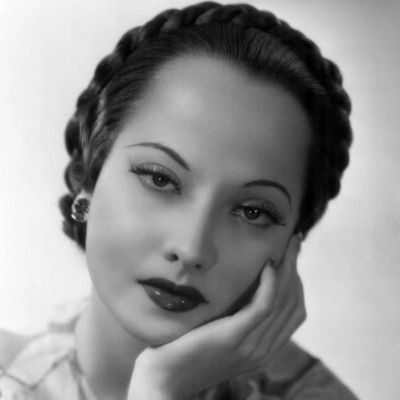
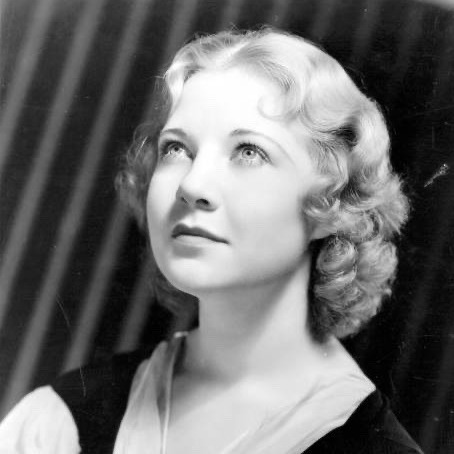
Propaganda
Merle Oberon (Wuthering Heights, The Scarlet Pimpernel)—She was mixed race (born in India and her mother was Sri Lankan) and still managed to make it in the British and American film industries (by passing) despite a rough start in life and industry racism. She was the first Asian person to be nominated for any Academy Award (best actress in 1935)! She also survived a car accident in 1937 and kept on acting until 1973, despite potentially career-ending facial scars. Also, she met her third husband while they were filming a movie together in 1973 (her last movie and she still looks great!). They fell in love and got married in 1975 when she was 62 and he was 36. She died 4 years later in 1979. Iconic.
Una Merkel (42nd Street, The Bat Whispers, Destry Rides Again)— una was “known for her Kewpie-doll looks, strong Southern accent, and wry line delivery” to quote wikipedia, and she was often found playing the the wisecracking supporting character. she was a fixture in 30s movies, appearing in as many as 12 a year as an MGM contract player, and it's always a pleasure to see her pop up in anything. “Whether she played harebrained ingénues, wisecracking best friends, feisty pioneer women, or cantankerous matrons, critics appreciated her quirky characterizations, which were made even better with her trademark Southern accent, deft comic delivery, and incomparable stage presence.”
This is round 1 of the tournament. All other polls in this bracket can be found here. Please reblog with further support of your beloved hot sexy vintage woman.
[additional propaganda submitted under the cut]
Una Merkel:

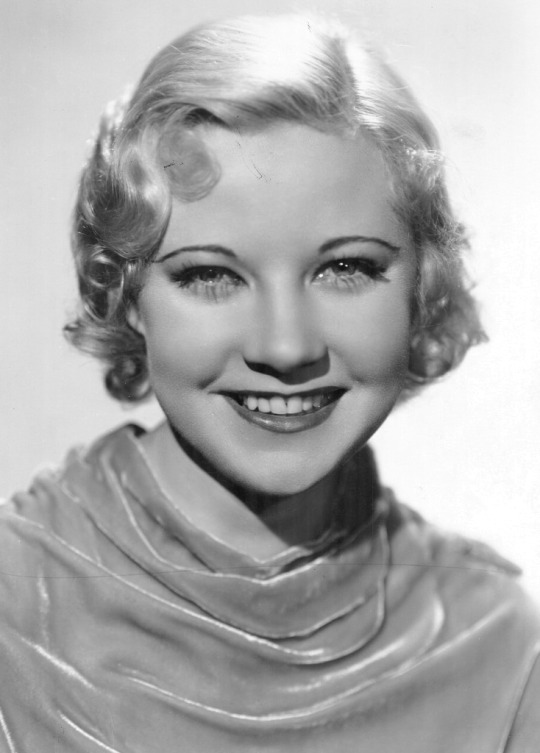
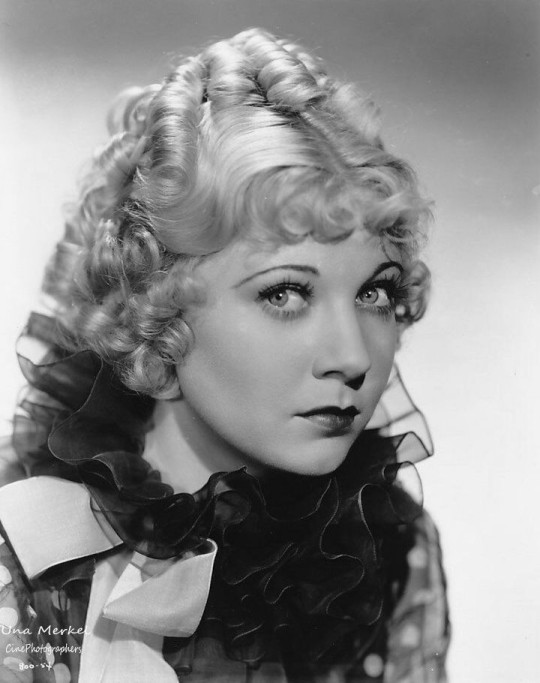
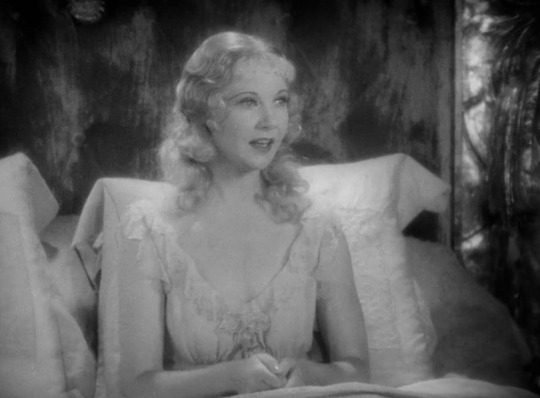

Merle Oberon:
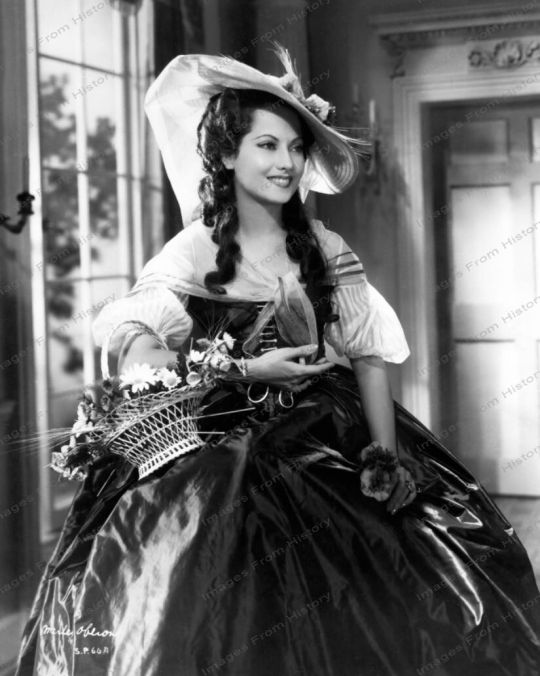
Beautiful. Talented. Biracial. Also please refer to the following promo from the aforementioned A Night To Remember, in which she plays the writer George Sand:
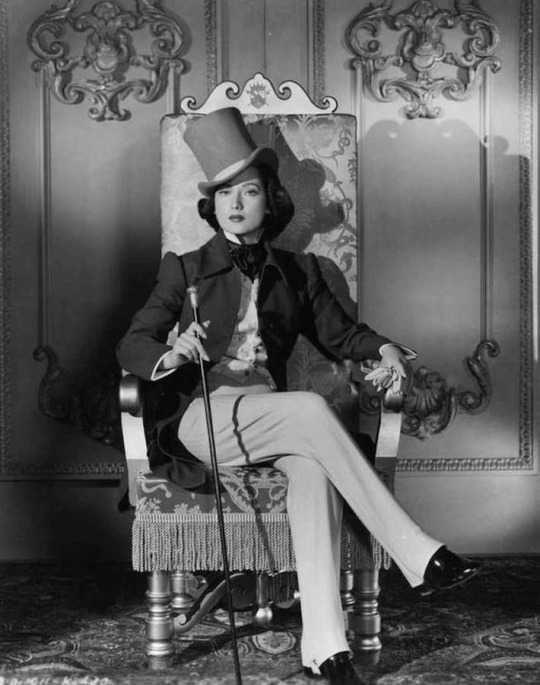
Her performances always give off this perfect blend of of being composed, refined, and aloof while still being deeply passionate and I eat it up every time.
I need all the gothic fans to STAND UP for our cathy!!

A rare example of a WOC working in lead roles in this era (mostly because she worked very hard to pass as white and had to hide her south asian heritage sadly). She has this very regal vibe but also a simmering intensity—even holding her own as Cathy opposite Laurence Olivier as Heathcliff.
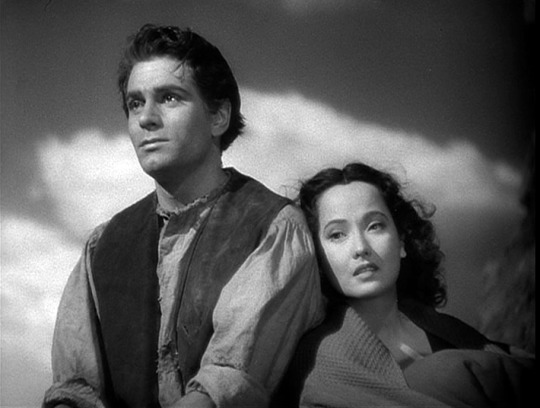
She has such a unique face when it comes to old hollywood actresses - a lot of them start to melt together in my brain - but Merle has always stood out to me<3
Linked gifset
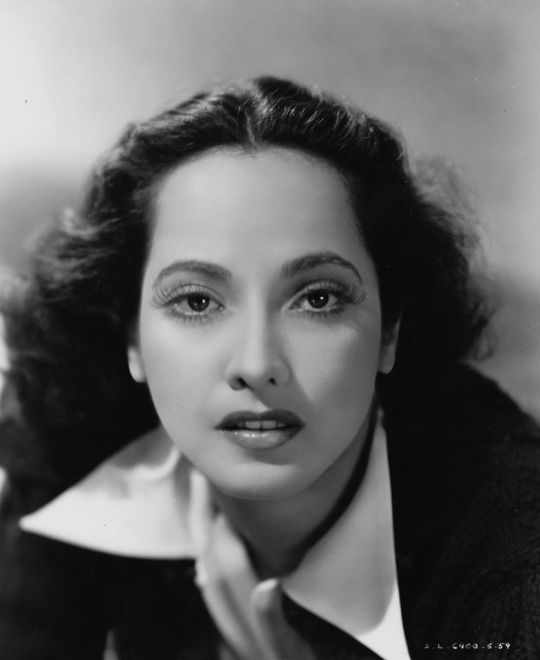
131 notes
·
View notes
Text
This article hits a lot of my discomfort around comparing the LTTE to Hamas, or any of the Palestinian resistance.
Do I believe in Tamil self-determination? Yes. Should they have a sovereign state? Yes. Should they have won the North instead of the SL military? Absolutely. Does any indigenous Tamil or Muslim person in the North and East have the right to armed resistance against majoritarian rule? Also yes. Was the LTTE rank and file fighters resisting annihilation and the SL military to a man was committing murder? Yes.
Do I believe the LTTE as an organisation and Prabhakaran as its head actually stood for anything but replacing the Sinhalese ethnostate with a Tamil one of their own choosing? Fucking no.
Navaratnam, after splitting away from the Federal Party, also published a newspaper, Viduthalai. I read the paper in the 1970s, when it often compared Tamils and Jews in terms of cultural character—including a supposed predisposition for intelligence and entrepreneurship—and argued that they were similar. (This line of thinking survives to this day: I know of Tamil nationalists in the diaspora who invoke the establishment of Israel as an example for their own goals, and see similarities in the Tamil and Jewish struggles.) Viduthalai also serialised Exodus, a popular 1958 novel by the American Jewish writer Leon Uris, which was translated by Navaratnam and published in Tamil as Namakkoru Naadu—A Country of Our Own.
Exodus presents a factually inaccurate but heroic account of the Zionist project to establish Israel as a Jewish nation state, and follows a group of Jewish arrivals in Palestine after the Second World War. It makes no mention of the mass dispossession and ethnic cleansing of Palestinians by Zionist forces in 1948. Edward Said, the Palestinian activist and intellectual, has highlighted how the novel dehumanises Arabs. Said has also argued that, when it comes to Israel, “the main narrative model that dominates American thinking still seems to be Leon Uris’ 1958 novel Exodus.” The British journalist Robert Fisk once described the novel as a “racist fictional account of the birth of Israel” in which Arabs are “rarely mentioned without the adjectives ‘dirty’ and ‘stinking’.”
Velupillai Prabhakaran, who established the LTTE in 1976, was a supporter of the Self-Rule Party as a young man. He would also have been a Viduthalai reader, and was inspired by Exodus. I was informed by a former LTTE member that the organisation also separately translated Exodus in full in the mid-1980s, and that it was widely distributed among LTTE cadres and supporters. Two prominent members of the organisation told me separately that the film adaptation of Exodus was also screened to LTTE cadres at camps in both Sri Lanka and the southern Indian state of Tamil Nadu.
Following long-term disillusionment with the LTTE, and seeing no democratic space to raise my concerns with the organisation’s autocratic leader, Prabhakaran, I quit the LTTE for good in April 1984. Many others also left, both before and after me, with the same concerns – among them the one-man leadership and complete intolerance for political discussion or difference. Some of them were murdered by the LTTE for leaving. One tragic example is Patkunam, one of the group’s founding members, who was murdered by Prabhakaran sometime in or around 1977 with the agreement of the appointed central committee of the LTTE. Prabhakaran suspected that Patkunam had been influenced by EROS’s leftist ideas and wanted to leave the LTTE. The LTTE had a policy that those who wanted to leave and join another group or establish another organisation would face capital punishment.
...
As it increasingly gained control of the North and East of Sri Lanka, the LTTE arbitrarily declared itself the “sole representative” of the Sri Lankan Tamil people. On this basis, it targeted Tamil activists from leftist and progressive organisations, killing or otherwise silencing them. The leadership of the TULF, the Tamil parliamentary party, was also wiped out. From as far back as the mid 1980s, the LTTE also suppressed other Tamil militant organisations such as TELO, PLOTE and the EPRLF. Eventually this meant targeted killings and massacres of both cadres and leaders from rival groups. Sections of EROS were forcibly absorbed into LTTE ranks. The LTTE also killed numerous EPRLF and PLOTE cadres who had received training from the PFLP in Syria.
...
In 1990, the LTTE executed a plan to ethnically cleanse Muslims from territories under its control in the North of Sri Lanka. The entire Muslim population of the Jaffna, Vavuniya, Mullaitivu, Mannar and Kilinochchi districts, numbering approximately 75,000 people, was evicted at gunpoint. This demonstrated the LTTE’s desire to establish an ethnically exclusive Tamil state, much like the Jewish state of Israel envisioned by the Zionists. The LTTE’s entire ideology was based on exclusive Tamil nationalism; its idea of a homeland and a nation meant treating Muslims and other minority communities in Tamil-dominated areas as second-class citizens at best. In this, it had uncomfortable similarities with the Zionist outlook on Palestinians and Muslims.
...
The LTTE was a right-wing organisation, with a statist approach to popular struggles. Prabhakaran made it clear that the LTTE would not interfere with “domestic issues” in other countries. I know this because, while I was with the organisation, he did not want to have any links with Marxist-Leninist parties in India as he did not want to antagonise the Indian state. The LTTE’s international network consistently aligned with Western governments and lobbied for their support. Although the LTTE was deemed a terrorist organisation and proscribed by the United States, the United Kingdom and the European Union, these governments’ notices stated clearly that the LTTE had no intention of targeting Western interests.
The LTTE leadership was a corrupt bunch of autocrats that ethnically cleansed and killed anyone that got in their way, including their own people, having solidarity with no one and led by a personality cult not so different from MR's. Nurturing Karuna and Pillayan at their breast while they massacred Muslims, conscripted children and killed and disappeared Tamil activists and journalists, and then crying foul when they defected to get away with their loot? Nah son. Just like the SL government, the LTTE didn't care what they were doing as long as they didn't do it to them. Because in their ego-driven ideology, Tamil self-determination began and ended with them. Even now, it continues to obstruct the Tamil struggle because, since the LTTE made itself and its own nationalist project the sole representative of Tamil freedom, their defeat in 2009 makes the Tamil resistance itself look like it's dead in the water. Tamil Eelam's generational legacy of varied ideologies, factions, alternative enterprises and coalitions that preceded them all erased by this one failed cadre.
Hamas is far from perfect, but there's a continuity to its evolution, a devolution of power within their ranks, a willingness to work as a coalition with other resistance groups, and a generational network of anti-imperialist, anti-colonial solidarity and diplomacy behind them. The LTTE was just cut from the same post-colonial ethnonationalist cloth as the Sinhalese majoritarian state. Freire spoke truly when he said that the oppressed see their model of manhood in their oppressor. As long as we continue to identify with the powerful instead of the powerless, we will never be anything but pawns in the imperial project of coloniality.
*I do wish the author hadn't just...glossed over the horror that was the Indian Peace Keeping Force. Those freaks somehow managed to commit worse massacres and rapes than the Sri Lankan military. Absolutely heartbreaking because so many Tamil people believed they would be their allies. It says a lot that both the government and LTTE had enough of their shit within two years that they came together to kick them out. This alliance also came in useful because it allowed the government to crush the JVP's Marxist insurrection in the South without having to fight a war on two fronts. By that I mean Premadasa was grand chums with the LTTE while his forces killed over 60,000 innocent people in the rest of the country. At least right up until the LTTE killed him. Lol. The late '80s was their trollface era.
#(yes I am on break. i had to come back to post this)#funny story though: israel once trained the SL army and the LTTE at the same time#without either knowing#the army was in tel aviv and the ltte in haifa i think#this settler colony runs on war profiteering lol#sri lanka history#sri lanka politics#tamil eelam#tamil struggle#tamil genocide#decolonization#anti imperialism#armed resistance#anti zionism#islamophobia#free palestine#LTTE#palestinian history#palestinian resistance#knee of huss
34 notes
·
View notes
Text
ELLO
WELCOME TO MY LIL BLOG GEHEHHEHEHHEHE If you made it here you probably found me yelling being silly in ur comments or somehow stumbled here bc of my other acct @tophatstintin gegehehhehhehehhehe:3
U CAN FIND MY STUFF WITH "tophat's stuff"
I tend to reblog tintin related things sjsnksksdjdbje
LIL INTRO
Name: Tophat Nationality: CANADAIN HBUGVYFCDCFGH Ethnicity: SRI LANKAN Pronouns: they/him (i mostly use they/them but i don't mind if u use he/him :3) NONBINARY AND TRANS :3 (i have homophobic parents irl so i have to settle for being nonbinary for now but i wanna be trans)
STUFF IM INTO RN (and favorite characters):
LORD OF THE RINGS/ THE HOBBIT-(Pippin)
BEYBLADE BURST-(Wakiya)
TINTIN-(I LOBE THEM ALL JNHBUGVCTR)
OBJECT SHOWS (bfdi, ii, hfjone, bfkfc, object manor, kfc :3-(don't really have one lol(kei b for kfc tho ugyfutdryytuyiu))
SMG4-(SMG3)
EDDSWORLD-(Tord)
A.V.A/A.V.M-(purple) DANDADAN-(okarun)
SHIPS I SHIP
LOTR/HOBBIT: Bilbo x Thorin, Sam x Frodo, Legolas x Gimli
BEYBLADE BURST: Rantaro x Wakiya, Valt x Shu, Ranjiro x Aiger
TINTIN: Tintin x Haddock
SMG4: Smg4 x Smg3
EDDSWORLD: Tom x Tord DANDADAN: momo x okarun




i haven't really done object oc's for lotr/hobbit, so if u have any suggestions on what objects they should be, feel free to suggest them :3
also as u can probably see, i haven't really posted much here and on my other acct in a while. its bc im having some family problems and i don't have my phone, so i can only post wb doodles for now :'[
ALSO FEEL FREE TO DM ME IF I FOLLOW U BACK :3 I DONT BITE HBGVYFCTDXRGVYBH

also i got some oc's gegehehehhehheheh
tophat, Yara, and Xavier are my osc OC's, the country ball one doesn't have a name lol (i'll just call it CB for now lol), TOO (The Only One) is my A.V.A/A.V.M (animation vs animator/animation vs minecraft (Allan Becker)) OC, and Theodore/Theo is my hobbit OC.
Tophat and CB both use they/them
Yara and TOO use they/her
Xavier and Theo use they/him
EDIT: FEB 1 2025 TOPHAT IS A GUY NOW

#osc art#the adventures of tintin#peregrin took#bagginshield#beyblade burst#wakiya murasaki#pippin#wakiya x rantaro#lord of the rings#the hobbit#smg4#smg34#smg4 x smg3#tintin x haddock#haddotin#eddsworld#idk what else to tag lol#i mayyyyyyyyyy edit this in the future lol#i is silly :3#ELLO WORLD#finally did this lmo#animation vs minecraft#animation vs animator#ocs#my ocs#oc art#original character#osc oc#osc ocs#country ball oc
25 notes
·
View notes
Note
What do you think of the possibility of other cultural inspirations being further included in to the Avatar universe?
While there was a new character design for the Avatar TTRPG revealed called “The Successor”, who seems to clearly have clothing inspired by Ainu fashion. Interestingly, he is apparently from the Southern Water Tribe. Perhaps, this could be a different village which is more directly based on Ainu people, rather than Inuit culture.
There have just been two new Air Nomad characters revealed for Avatar Generations, who appear to be based on Indian people. Their names are Sameera and Nethaka. They were just revealed in a livestream.
Realistically, I am still skeptical about any of the new lore from the TTRPG & Avatar Generations actually being adapted into the animated works of Avatar Studios. Although, I’d love to see it actually being cohesively tied in to the universe. Since, I think that these mediums have actually been adding such great lore to the franchise, which seems have to gone largely unnoticed by the fandom.
Lastly, are there any cultures that you’d think could still fit nicely into Avatar world as inspiration? Personally, I’d love to see Aboriginal Australian & Polynesian cultures also being explored in the franchise.
I think there's a very good chance that the extended Avatarverse will have additional cultures added as the franchise continues.
Regarding "The Successor" (Kahola), I've actually written at length about his design here and here. I really like his look, but I think his design would have been more appropriate for a Kyoshi Island character.
According to the Avatar wiki, Sameera and Nethaka are based on Sri Lankan Buddhists. As Sri Lanka is 70% Buddhist, it's a great source of inspiration for the Air Nomads. I'm really happy that they've added South Asian-coded characters to the Air Nomads. They were already implied to have existed by Pathik being described as a "spiritual brother to the Air Nomads"; which I took as a euphemism for him being a non-bender with Air Nomad ancestry. It also contributes to my headcanon that the four air temples each reflect different regions with large Buddhist populations: South Asia, Southeast Asia, East Asia, and the Himalayas.
I like the idea of the Water Tribe having various settlements all over the Avatar world that each have a different culture. A Polynesian-inspired Water Tribe settlement that developed on a remote Fire Nation island--- probably prior to Sozin converting the country into a despotic ethno-nationalist state--- would be fun to explore.
122 notes
·
View notes
Text
also for newer followers who might not know

i'm writing a book! and it's getting published!
if you just want the immediate details you can click the read and read a short FAQ! if you need more to get sold on it, stick around and check it out!
My YA SFF fantasy debut, ALVOSKIA: Call of the Infrans, follows an Unchosen one named Ally who is struggling to find where she belongs amidst her chosen one found family family when violence arrives at their doorstep, and they're forced to fulfil their duties earlier than expected. There's dragons and child soldiers and subverted fantasy tropes, some tone consistent werewolves, an almost entirely queer main cast with the majority also being characters of colour, and if you've been following my blog for any amount of time, it probably has something for you.
If you like ATLA: "what if there were multiple Avatars running around, and what if they weren't all automatically good people?" + past lives and reincarnation cycles
If you like Derry Girls: hot mess of teenagers getting in and out of trouble together while being ridiculous (and sometimes very sad)
If you like PJO: young teenagers with cool powers going on quests together and coming-of-age. And snark. Lots of snark
If you like Six of Crows: morally dubious collection of protagonists, some heisting may or may not happen, outsiders working together
If you like TDP: elves and dragons and long standing grudges and politics
If you like Star Wars: y'know how the Force like consumes you the farther you wander in? yeah that's the magic system here. + some shadow, death, and shapeshifter stuff
If you like HTTYD: you're here for the found family and fun fantasy aesthetic aren't you
Rep: queer (aro, ace, bi, pan, trans, lesbian, nonbinary, genderfluid, gay main characters, often times overlapping); Asian (Indonesian), Black, Sri Lankan and Pakistani (coded) rep; hijabi rep; one character is an amputee and one main character is Autistic.
The debut month is March 2026! Sometimes there is even very pretty (commissioned or friends) art for it:

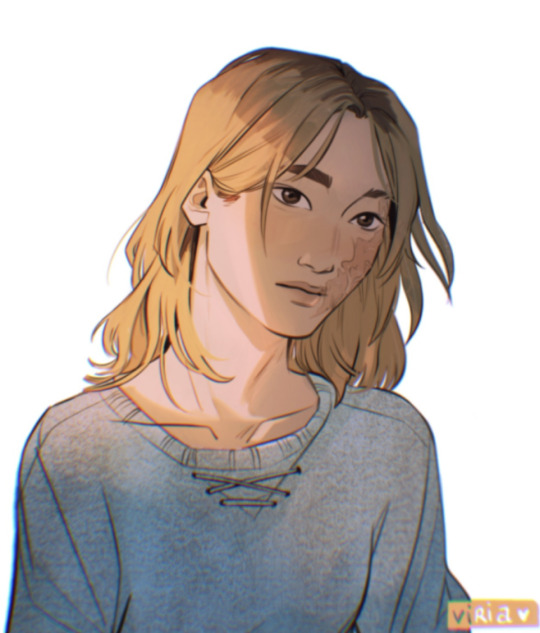
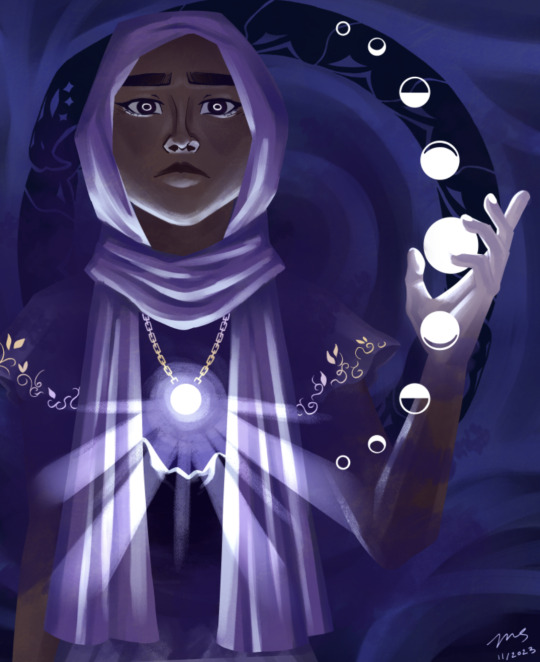
If you want more info in the meantime you can shoot me an ask or you can follow this sideblog for it. If you want a taste of my fandom writing first you can check out my AO3 or writing snippets on said side blog, like this one:
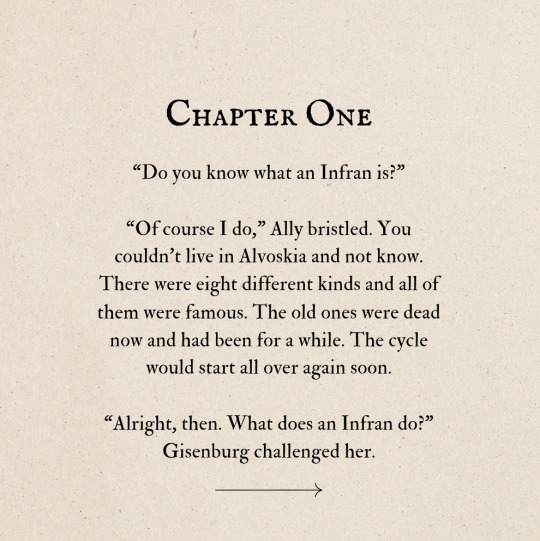
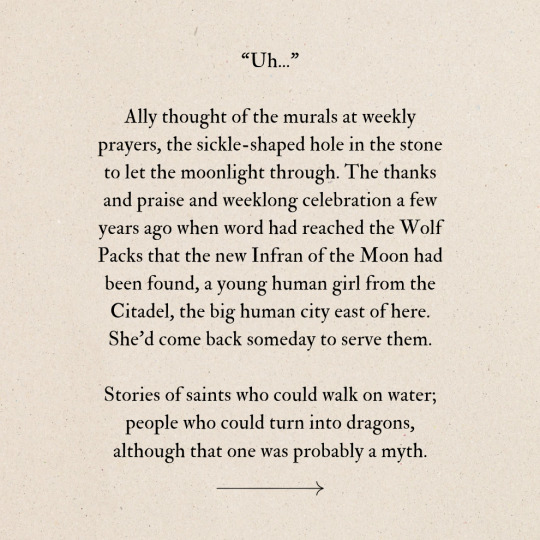

Likes and reblogs mean a lot and I hope you enjoy!
#indie author#sff ya#sff#young adult#writeblr#fantasy#original character#infrans#alvoskia#atla#pjo#derry girls#httyd#sw#six of crows
51 notes
·
View notes
Text
Kat's Top Books of 2023
Was inspired by someone else's post to do a Kat's top 5 books of the year post culling from my #recently reads. I read a lot this year and encountered a lot of great titles, but these ones were particularly memorable:
Vagabonds! by Eloghosa Osunde. Interconnected short stories following the lives of queer misfits and outcasts in Nigeria. I have a passage saved on my phone. I read this back in January so I don't remember the contents as much as the feelings it evoked, but it was beautiful and haunting.
Don’t Fear the Reaper by Stephen Graham Jones. Read My Heart is a Chainsaw first if you haven't already. The books pit Jade Daniels, a young woman with a trauma she's refusing to face head on but instead buries in an obsession with the moral logic of slasher films, against irl slashers who keep coming to town. Bonus points for wired jaw representation, aka my future.
Brotherless Night by V.V. Ganeshananthan. Set during the Sri Lankan civil war following a young Tamil woman who's caught in the middle as loved ones join the Tigers. It starts with a striking passage that you think means one thing and then comes back later in a way you don't expect that's a huge gut punch.
The Spear Cuts Through Water by Simon Jimenez. A high fantasy story that is also a diaspora story as the characters' scattered descendants watch history play out. Dips into everyone's thoughts to create a chorus POV that's really effective. Note - incredibly gruesome. Organs, lovingly described, etc.
The Golem of Brooklyn by Adam Mansbach. A stoned art teacher accidentally creates a golem who decides his mission is to stop an upcoming alt right rally. Explores the interactions between the old world and the new and the weight of historical trauma - every golem shares the same ancestral memory. Carries its tensions to the very last page and leaves the reader to supply the answers.
(Honorable mention to System Collapse which didn't make it into the #recently read posts, but I had a great time!)
Nonfiction shoutout to A City on Mars which sourced so many delightful space facts and gave me a lot to think about re: SF worldbuilding that is at all grounded in reality. Plus it was really funny.
51 notes
·
View notes
Text
Most of this was drawn in September of last year, but I decided to finally complete it!
So, here are the penguins of Madagascar and their lemur friends as humans!

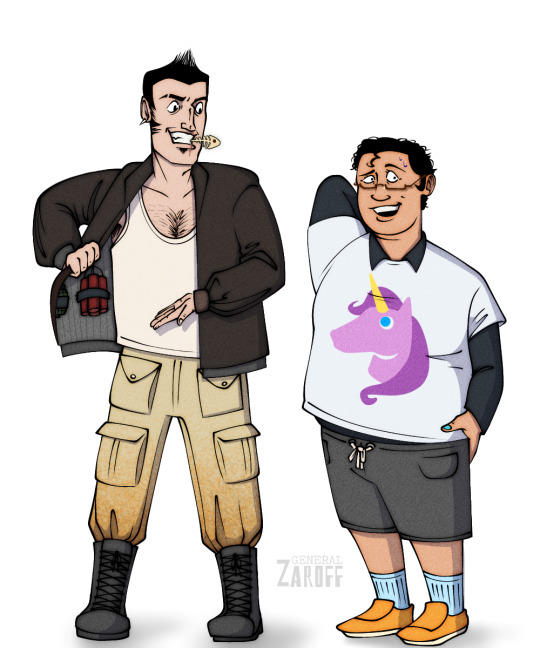

I know this has been done to death already, but I wanted to provide my own interpretation. I’ll provide my design choices for each character under the cut, if anybody’s interested!
Skipper: I do not want to throw shade to anyone, but most of the human Skippers I’ve seen are either too young, too skinny, or too muscular. This guy may present himself as an authority figure, but let’s face it: this guy is your average middle-aged man with a fascination for cool spy stuff and repressed bisexuality. Trust me, my dad knows all about it. Anyway, I gave him a tacky nautical flag shirt, mostly because i couldn’t find any high-quality “hawaiian shirt with wwii planes” patterns. If it weren’t for King Julien’s design, I would’ve given Skipper aviators.
Kowalski: Typical nerdy guy. When I was showing a work in progress of the penguins, a friend of mine suggested that Kowalski’s hairline should be extra receded, and they were right. I know that this is the simplest design, but that’s because this guy just doesn’t seem the type for style. More of a practicality and formality guy. I suppose now’s a good time to mention that each of the brothers has an element of orange around their feet, cuz, well, the penguins have orange feet.
Rico: I really hope you guys get the energy that this guy listens to nu-metal. Since human beings not infused with cartoon animal wackiness cannot regurgitate convenient items, I decided to give human Rico a bunch of pockets from which cartoon HUMAN wackiness can occur. His outfit is also a bit more military-like than the others, what with the bomber jacket, cargo shorts, and combat boots. I also gave him what is essentially the boss floss from Splatoon 3’s amiibo gear.
Private: According to Penguin Lore™️, they’re all brothers, but Private is adopted, hence why he’s a bit younger [but not a child!] and I gave him a different hair texture and skin tone. His shirt has an icon from his favorite show, a Lunacorn. I also made his blue nail polish match its eyes. I take honor in the fact that a friend told me “I have several transmasc friends who look like this”.
Maurice: A lot of people who draw TPOM gijinkas don’t even draw him, which is a shame, because I love Maurice. Even more offensive is that some people don’t even depict him as an old black man, which goes against everything I know to be true in my heart. Anyway, he seems like the type to enjoy autumn/winter gear, so I gave him a big ol’ trench coat, as well as a scarf that looks like his fur puff. And the newsie cap just felt right.
King Julien: Here’s where all the flashiness went! According to an actor whom I have a personal vendetta against and thus will not name, Julien’s accent is Sri Lankan, so I took inspiration from their traditional clothing for his outfit, albeit more “cunty”, as today’s kids call it. It was imperative that this man has his toes out for obvious reasons, so I gave him sandals. I honestly have no good explanation for the leopard print leggings other than it came to me in a divine vision. Or something. The sunglasses mimic the color of his eyes!
Mort: Look, it was really hard for me not to just draw Molière from Atlantis: The Lost Empire, since his design is already kind of what I imagine this fellow looking like as a “human”. Admittedly, I’m not too proud of this design, but i think it gets the job done. His outfit purposely clashes: a matching hat and sweater, but with sweatpants, and he’s not even wearing shoes! I know the original Mort doesn’t have any purple in his design, but I felt like its inclusion made him look a little weirder. And then there’s his eyes. Yeah.
Hope this wasn’t too long, and thank you to anyone who read this portion of the post!
25 notes
·
View notes
Text
So I just finished this great indie turn based RPG called Thirsty Suitors. It's about a queer South Asian Sri-Lankan young woman named Jala returning to her hometown to try and make amends with her exes and her family. It has straight, bi, gay, transgender, and nonbinary characters of color and also features a cooking mini game and skateboarding. It's a story of reconciliation, joy, intergenerational trauma, and imperfect people learning to see themselves in a better light. It's one of the most unique games I've played this year and I want others to play it too.
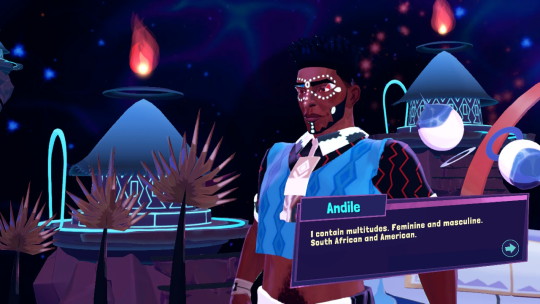

42 notes
·
View notes